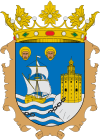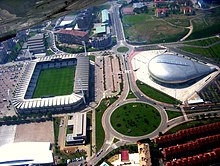Santander
| Santander municipality | ||
|---|---|---|
| coat of arms | Map of Spain | |

|
|
|
| Basic data | ||
| Autonomous Community : |
|
|
| Province : | Cantabria | |
| Coordinates | 43 ° 28 ′ N , 3 ° 48 ′ W | |
| Height : | 15 msnm | |
| Area : | 34 km² | |
| Residents : | 172,539 (Jan 1, 2019) | |
| Population density : | 5,074.68 inhabitants / km² | |
| Founding: | 26 BC BC as Portus Victoriae Iuliobrigensium | |
| Postal code : | 39001 - 39012 | |
| Municipality number ( INE ): | 39075 | |
| Nearest airport : | Santander Airport | |
| administration | ||
| Mayor : | Gema Igual Ortiz ( PP ) | |
| Website : | www.santander.es | |
Santander (span. [ Santan'deɾ ]) is the capital of to Spain belonging to the Autonomous Community of Cantabria in the north of the Iberian Peninsula . Over a third of Cantabrians live in Santander.
The city is a popular seaside resort in northern Spain. Its numerous sandy beaches are an attraction for many mostly Spanish tourists. There are several extensive sandy beaches, especially in the El Sardinero district. Surfing is possible on the beaches. El Sardinero is home to the casino and the Campos de Sport de El Sardinero , the stadium of the Racing Santander football club .
history
During the time of the Roman Empire , the city was named Portus Victoriae Iuliobrigensium . Its current name is derived from that of the early Christian martyr Emeterius ( Sancti Emetherii > Sancti Emderrii > Sancte Endere > Santendere > Santanderio > Santander ), whose head, according to legend, was brought to Santander in the 3rd century. In 1187, Alfonso VIII of Castile appointed the abbot of San Emeterio as head of the city. In 1248 Santander took part in the battles of conquest of Seville and received as a thank you its own city coat of arms, which contains the images of the Torre del Oro and the Guadalquivir river in Seville.
Santander was an important port city for Castile in the late Middle Ages and then also for the beginning trade with the New World . Santander received official city rights in 1755.
On November 3, 1893, the fire-fighting freighter Cabo Machichaco with 51 tons of dynamite on board exploded in the port of Santander. 590 people lost their lives in one of the most momentous disasters in Spain, and 525 injured had to be treated. The blast from the explosion destroyed nearby houses.
Santander also became King Alfonso XIII's favorite summer residence . from Spain and later remained a popular holiday destination. On August 26, 1937, during the Spanish Civil War , the city was evacuated by the Republican troops under pressure from the nationalists .

The great fire of 1941
Santander was the victim of a major fire in 1941 that started in Calle Cádiz near the pier. Strong south winds fanned the fire and drove it into town. The fire burned for two days. There was one fatality; one firefighter died in action. Thousands of families have been left homeless. The fire almost completely destroyed the historical part of Santander. The Gothic cathedral was also destroyed and later reconstructed. The reconstruction of the city changed the original urban configuration of the city considerably.
Population development
For years, Santander has been the largest city in the region with almost 200,000 inhabitants and is one of the 40 largest on the list of cities in Spain .
| 1981 | 1986 | 1991 | 1996 | 2000 | 2004 | 2006 | 2008 | 2009 | 2010 |
|---|---|---|---|---|---|---|---|---|---|
| 180.328 | 186.145 | 191.079 | 185.410 | 184.264 | 183,799 | 196.836 | 182,302 | 182,700 | 181,589 |
Worth seeing
Due to the major fire of 1941, the city hardly has any historical buildings. The rebuilt cathedral contains the bones of Saints Emeterius and Celedonis , the patron saints of the city. There is also a prehistoric museum in the city, which exhibits objects from the Altamira cave, among other things . The Maritime Museum of the Cantabrian Sea, designed as a tribute to this region of northern Spain to its sea. The Centro Botín , which opened in 2017, was designed by the architect and Pritzker Prize winner Renzo Piano and is a museum for modern art and a cultural center. The last equestrian statue of the former dictator Francisco Franco that remained in public space in Spain was located in the city center until the end of 2008 .
A round trip by boat from the Estación Marítima Los Reginas through the bay of Santander around the peninsula La Magdalena to the lighthouse Cabo Mayor and back gives a good view of the city . From the same station - also by boat - the opposite beach of Somo can be reached, which stretches far into the bay of Santander. The road "Avenida de la Reina Victoria" runs along the coast near the La Magdalena peninsula, which invites you to take a stroll due to its proximity to the marina of Puertochico. A little further you will find the "Paseo de la Pereda" with beach promenades and gardens.
In the city center there are numerous bars and restaurants, mainly in the area between the central square “Plaza de Cañadío” and the port “Puerto Chico”.
In 2005, Santander celebrated its town charter 250 years ago.
The Santander airport is also served from Germany. It is only five kilometers from the city center; For the transport from the airport to the city, we recommend the bus, which commutes every half hour. The closest two airports are Bilbao Airport approx. 100 kilometers to the east and Asturias (Oviedo) Airport 210 kilometers to the west. For trips within Spain , the bus station and the two train stations of RENFE and FEVE at the "Plaza de las Estaciones" are ideal. There is also a ferry connection between Santander and Plymouth .
In the outskirts of Santander, especially in the neighboring town of Maliaño , large shopping centers such as “Valle Real” or “Peñacastillo” have been built with specialist shops, wholesale markets and department stores. As a result, you will look in vain for a shopping mile in downtown Santander, as you would expect in a big city. But there are even more delicacies and luxury boutiques available.
Museums and cultural assets
- Santander Cathedral , was built between the end of the 13th and 14th centuries on top of other earlier buildings from Roman times . After the fire in 1941, restorations replaced the original apse with a wide transept and a dome.
- In 1840 the Sardinero was still an undeveloped landscape by the sea in the vicinity of the city. From 1850 the first tourists came and the first bathhouses and inns were built. As a result of Queen Isabella ll's summer vacation . In 1861 in Sardinero and later Amadeus I of Savoy in 1872, the area gained fame and attracted a large number of tourists. There was spectacular urban and cultural advancement with the construction of several hotels, cafes, trains, and trams that reached the Sardinero.
- The Palacio de la Magdalena was built in 1909 as a gift from the population for the Spanish royal family.
- Centro Botin : Themuseum and conference center designedby Italian architect Renzo Piano opened in 2017. The museum is part of the Botín Foundation and hosts art exhibitions.
- The El Faro de Cabo Mayor lighthouse presides over the entrance to Santander Bay and is one of the most emblematic and impressive structures for the citizens and visitors of Santander. Since 2005 it has housed the Centro de Arte Faro de Cabo Mayor , art center and museum, seat of the Sanz-Villar Collection with works by international artists such as Alfredo Alcain , Eduardo Arroyo , Javier Mariscal , Christian Awe and Fernando Bellver .
"Smart City"
Santander is a pilot project for a smart city . To do this, the city was networked with 12,000 sensors. Local public transport, the search for a parking space, garbage collection, street lighting and the irrigation of the parking facilities are digitally controlled there as required. Other cities are Belgrade , Guildford and Lübeck .
Universities
On the offshore peninsula " La Magdalena " there is a 1912 for King Alfonso XIII. Built castle , which today houses the Menéndez Pelayo International University . This university is a summer university. A particular aim is to impart the Spanish language and culture to foreign students. The university has a second campus for this purpose. It is located in the immediate vicinity of the University of Cantabria, which was founded in 1972 . With around 12,000 students (2004) it is the largest university in Cantabria and offers a wide range of subjects.
The Universidad Europea del Atlántico is a Spanish private university founded in 2013 and located in the Technology Park of Cantabria (PCTCAN).
sports clubs
Santander is home to the Segunda División B - Racing Santander football club . He plays his home games at the El Sardinero stadium . The greatest success of the club, which was founded in 1913, is the runner-up in 1931. In the ASOBAL league , the highest division of handball, the CB Cantabria Santander , a two-time Spanish champion and a Champions League winner, competes. With Cantabria Lobos , a basketball club from Santander plays in the second highest division . Both the CB Cantabria and the Cantabria Lobos play their home games at the Palacio de Deportes .
sons and daughters of the town
- José de Madrazo y Agudo (1781-1859), painter
- Concha Espina (1869–1955), writer
- María Gutiérrez Blanchard (1881–1932), painter
- Ángel Herrera Oria (1886–1968), politician and cardinal
- Gerardo Diego (1896–1987), writer
- Matilde Camus (1919–2012), poet and writer
- Enrique Orizaola (1922–2013), football player and coach
- Marquitos (1933–2012), football player
- Emilio Botín (1934-2014), banker
- Álvaro Pombo (* 1939), writer
- José Manuel Abascal (* 1958), middle and long distance runner
- Juan Francisco Muñoz Melo (* 1959), handball player
- Jesús Puras (* 1963), rally driver
- Eduardo Noriega (* 1973), actor
- Iván Helguera (* 1975), football player
- Pedro Munitis (* 1975), football player
- Iván de la Peña (* 1976), football player
- Ruth Beitia (* 1979), track and field athlete
- Gonzalo Colsa (born 1979), football player
- Fernando San Emeterio (* 1984), basketball player
- Beatriz Fernández (* 1985), handball player
- Edu Bedia (* 1989), soccer player
- Jesús Ezquerra (* 1990), cyclist
- Sergio Canales (* 1991), football player
Views
Banco Santander headquarters
Web links
- City administration website
- Regional daily newspaper El Diario Montañés (Spanish)
- Illustration by Daniel Meisner from 1625: Santander. Christo Sic Duce Liber Ero ( digitized version )
Individual evidence
- ↑ Cifras oficiales de población resultantes de la revisión del Padrón municipal a 1 de enero . Population statistics from the Instituto Nacional de Estadística (population update).
- ↑ Geoclimate 2.1
- ↑ Santander | Country & People | Surf vacation. Retrieved on September 23, 2019 (German).
- ↑ Santander Cathedral. Retrieved August 18, 2020 .
- ↑ Home. Retrieved August 18, 2020 (American English).
- ↑ Faro Cabo Mayor. Retrieved August 18, 2020 .
- ↑ Thomas Urban , tested in the laboratory sz.de , July 17, 2017.
- ^ Santander The Smartest Smart City. Governing, May 2014
- ↑ SmartSantander website












